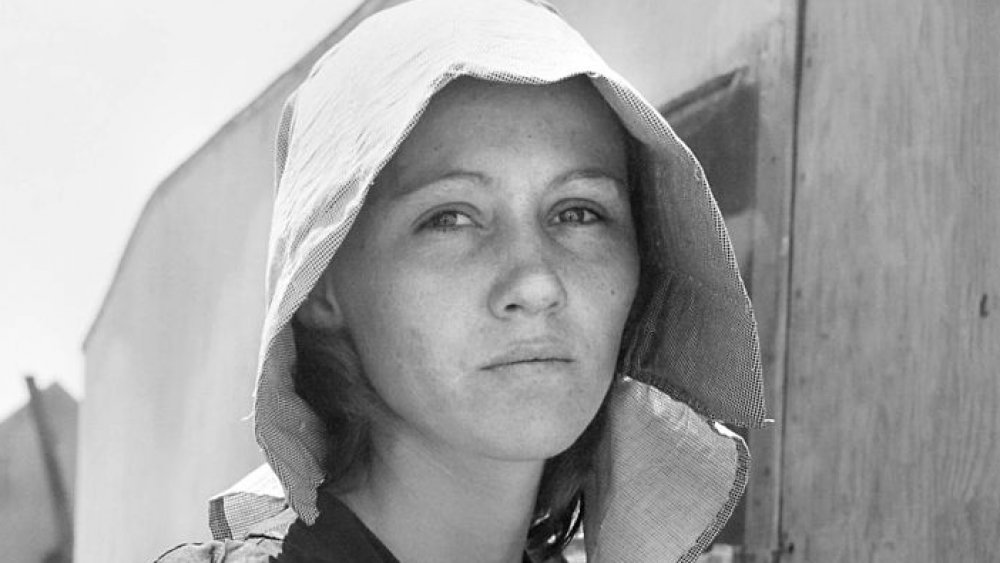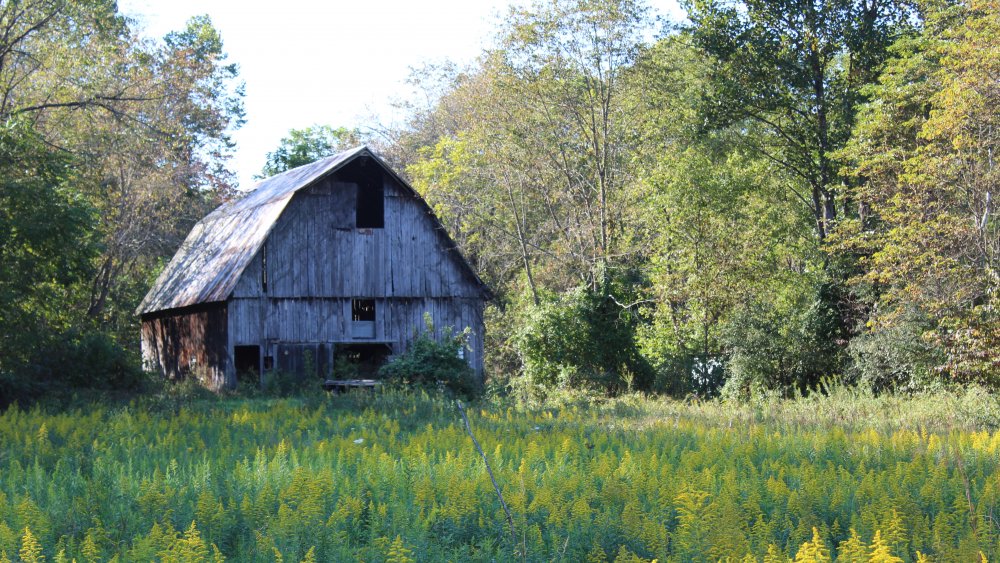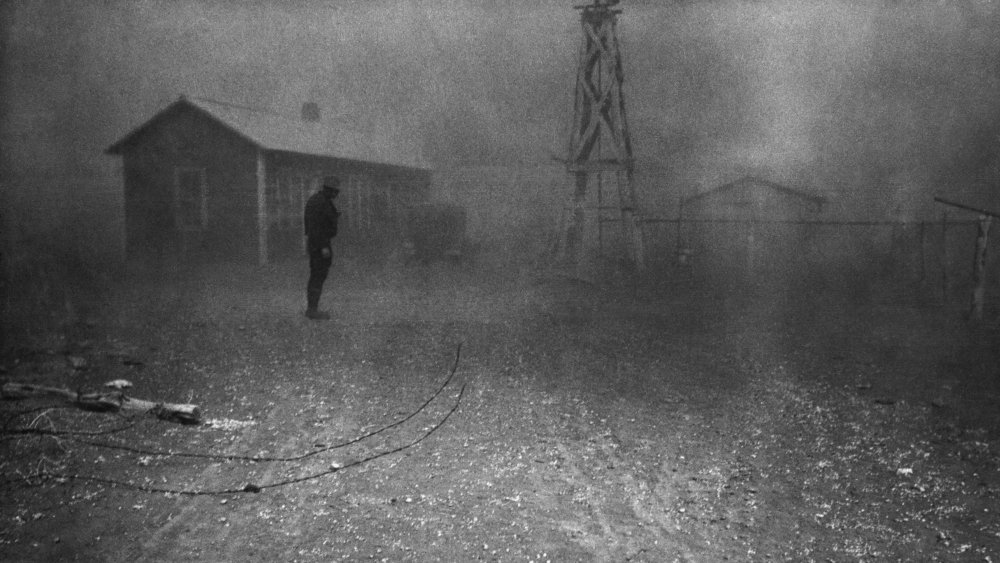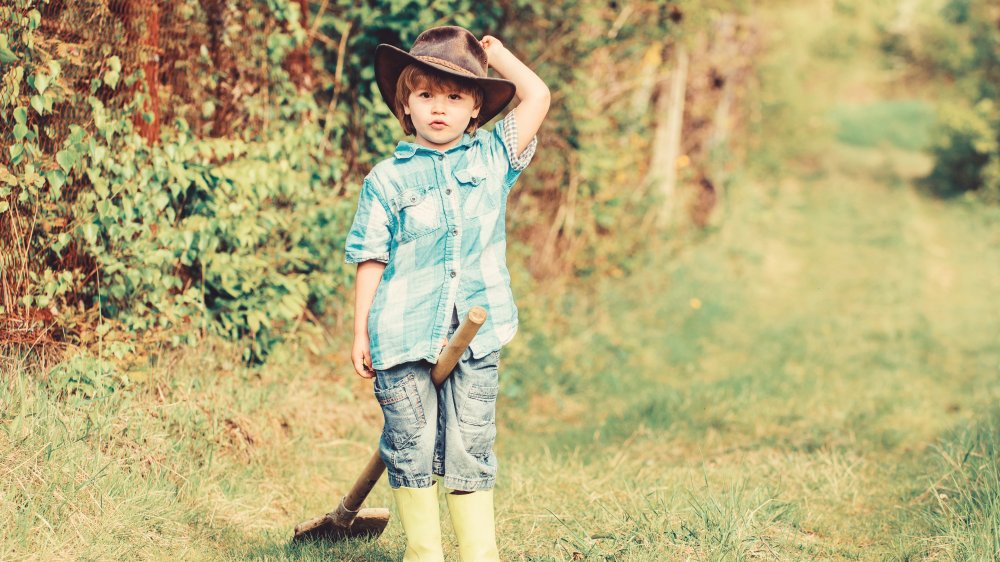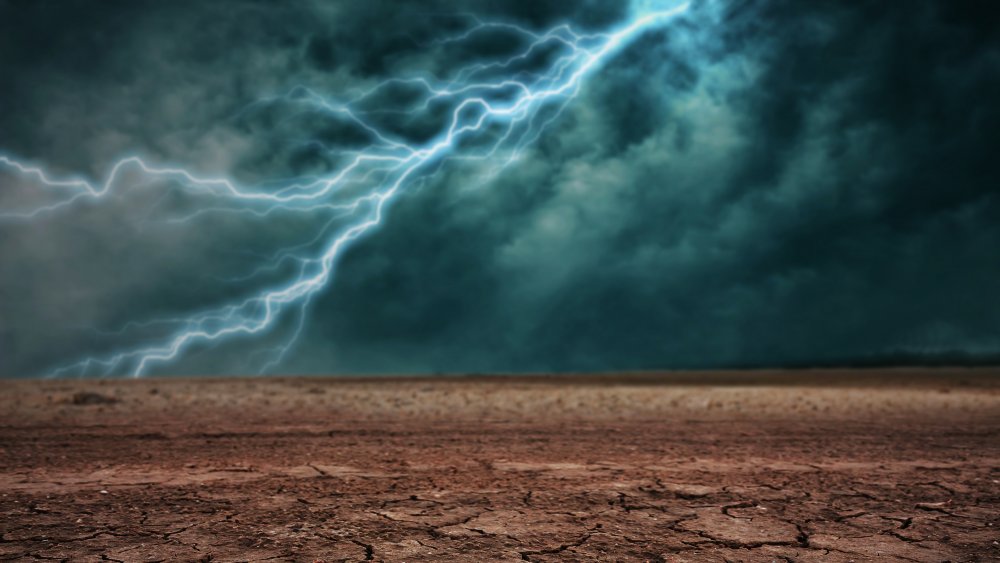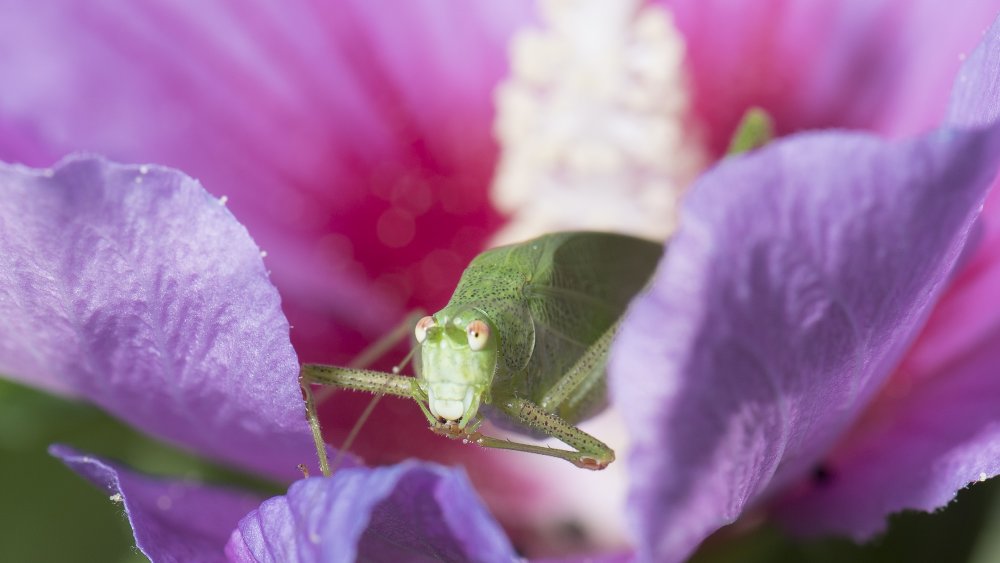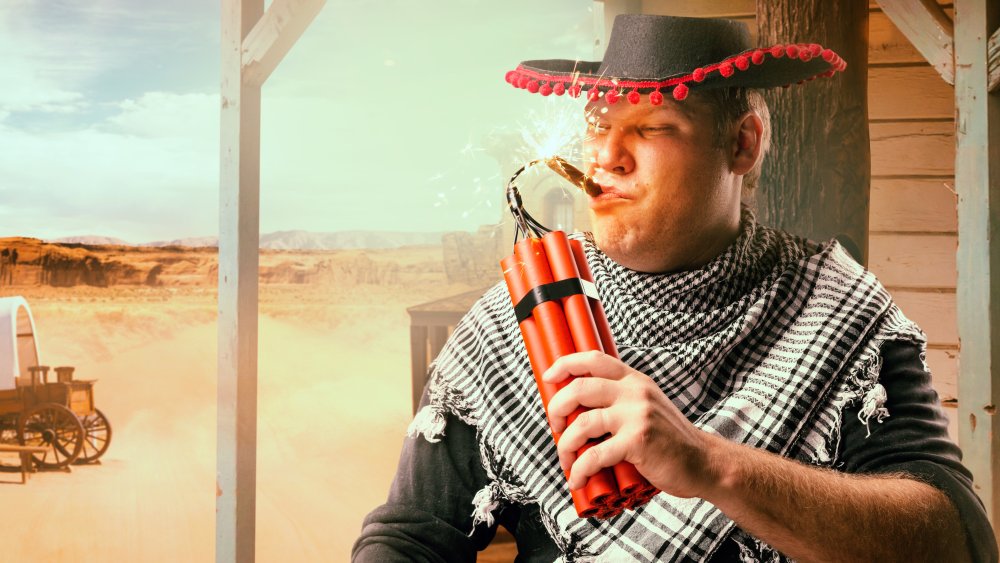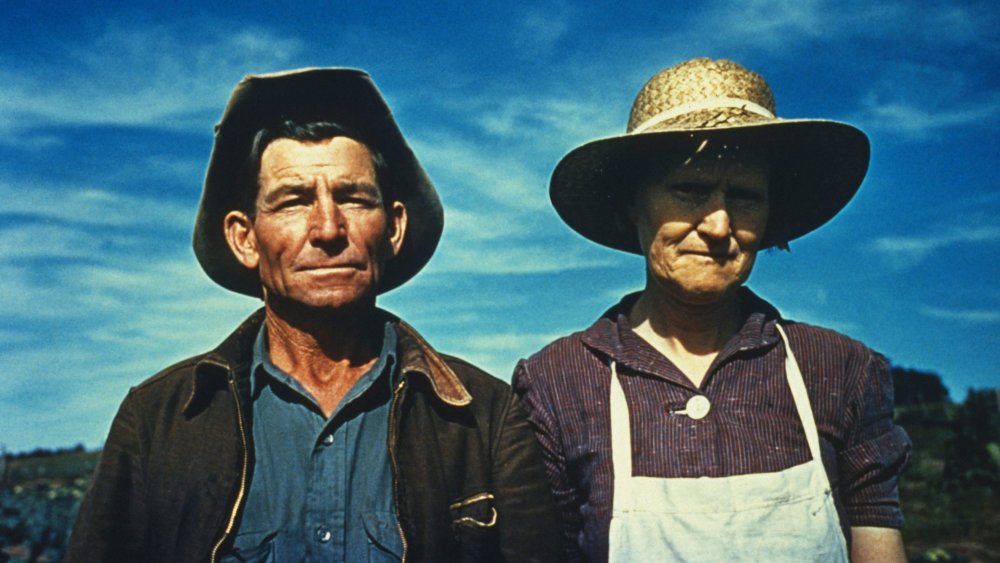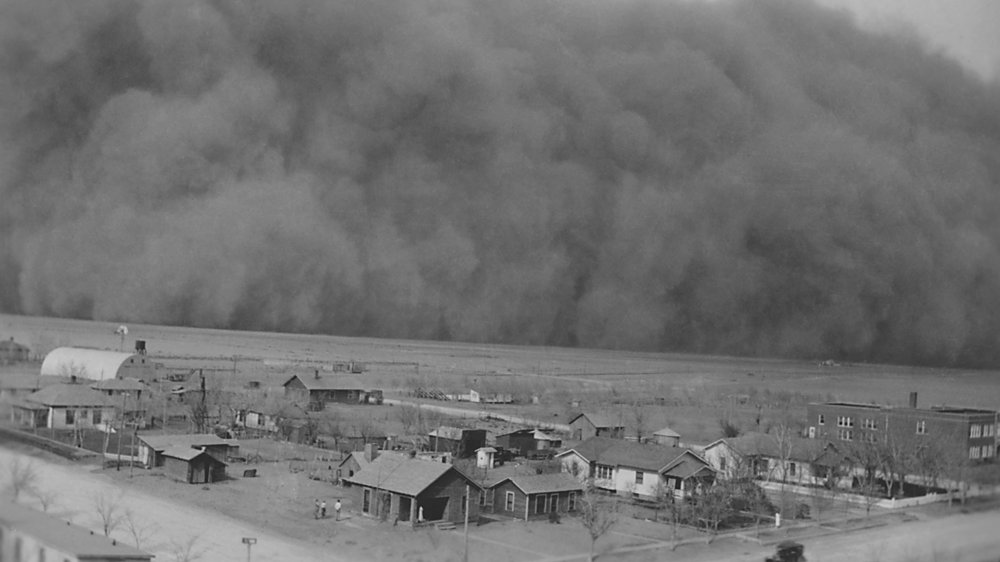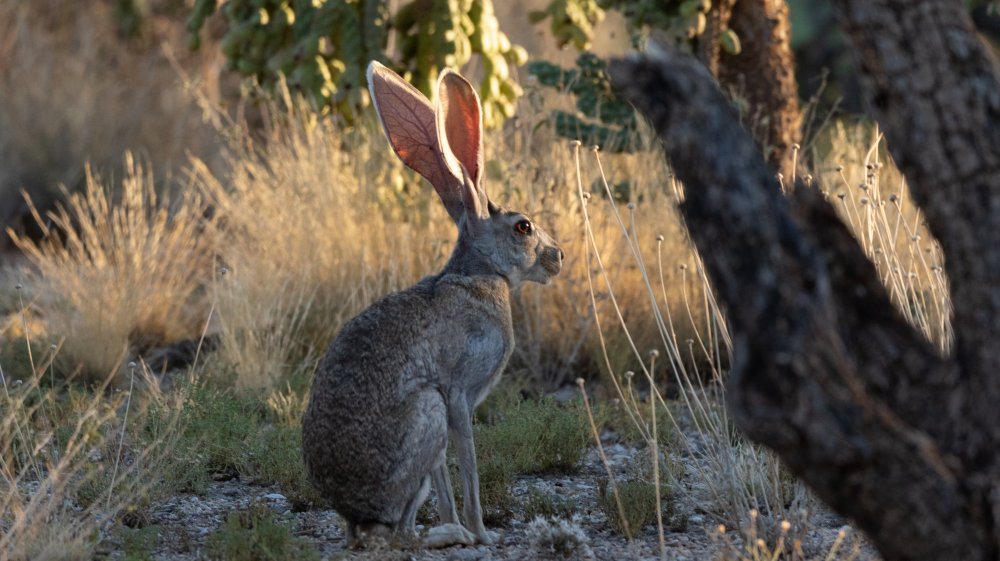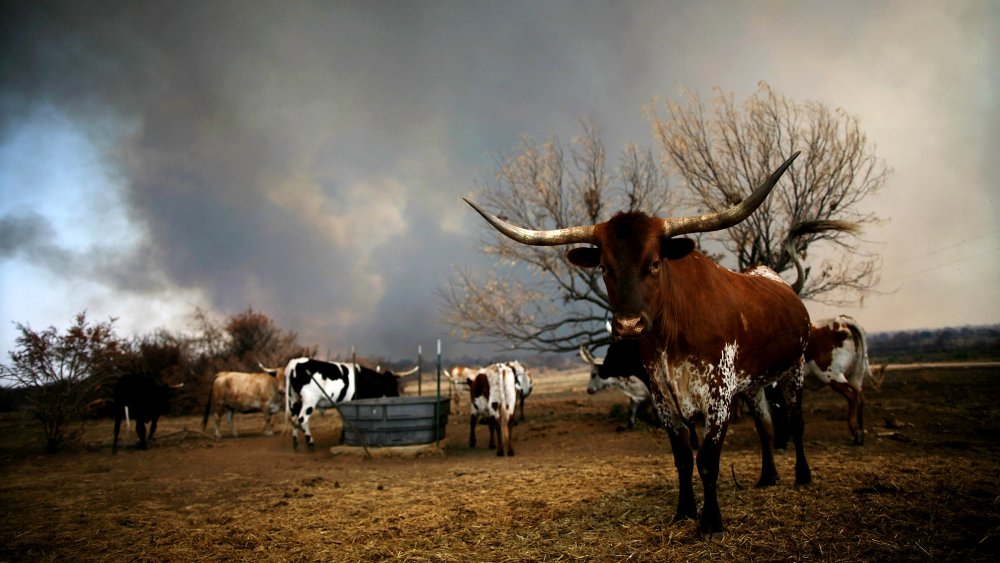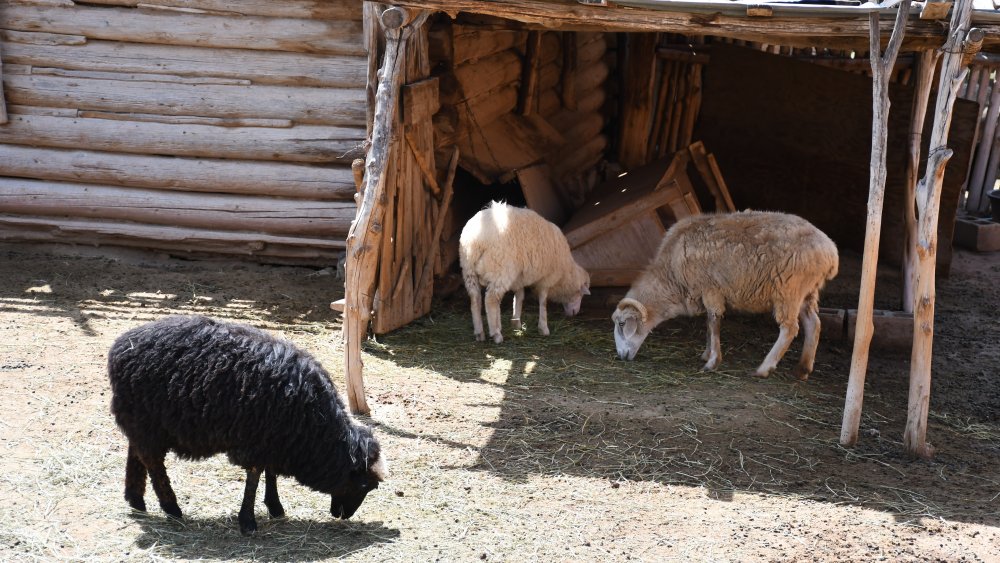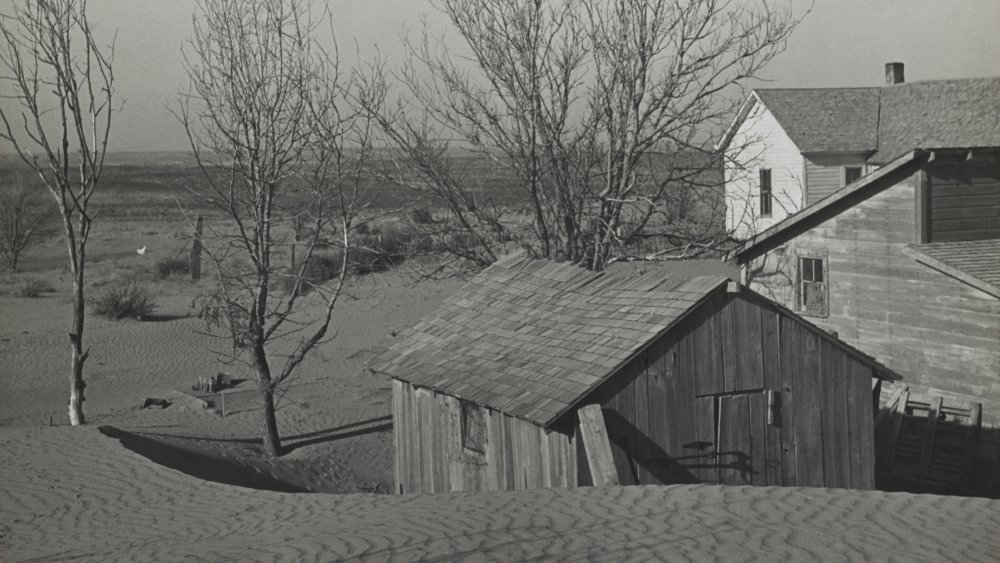The Messed Up Truth Of The Dust Bowl
It's easy to look back at the past, and think about how nice it would have been to live in those simpler times ... the times before the pressures of social media, online bullying, and devices in your house that listen to your every word. But when you take a good, long look at just what it would have been like to live at various times in history, you'll find that things aren't all they're cracked up to be.
Take the 1920s and 1930s. Sure, the idea of every day being a Great Gatsby-esque party at a local speakeasy sounds great, but times were shockingly difficult. The Great Depression kicked off with the stock market crash of 1929, and it ruined the country's economy for an entire decade.
As if that wasn't bad enough, farmers in the Midwest were hit with a double whammy. Starting in the 1930s, one of the most devastating natural events in the country's history swept across the Southern Plains region. Everything was choked with dust and dirt, crops failed, animals died by the score, and the effects were far-reaching. It was the Dust Bowl, and it was more horrible than you can imagine.
The Dust Bowl was created by the perfect storm of human activity and bad timing
At its heart, the Dust Bowl was the result of severe drought that turned the dirt on farmlands across the Midwest to dust. That dirt and dust was picked up by the winds, and it got everywhere. Crops failed, families starved and suffocated, and many fled their homes in search of somewhere they could make a life ... and escape the suffocating dust.
There were a few reasons this happened, and it was sort of the perfect storm of bad luck. It started in 1862, when the government started passing legislation that encouraged families to settle on patches of public land. The idea was that they would turn this into more valuable farmland, and they did. According to History, the popular belief at the time was that "rain followed the plow," meaning that if farmers tilled the land, the climate would change to be more favorable.
After World War I, wheat and grain prices skyrocketed. Still more land was plowed to keep up with demand, but when the Great Depression hit, the bottom dropped out of the market. Farmers needed more land and more crops to break even, and it was this terribly overworked land that was ravaged by severe drought. Farmers had destroyed the native ecosystem that kept valuable topsoil in place, and when the heat and winds came, everything began to erode. It was an environmental and economic disaster on a national scale.
The black blizzards of the Dust Bowl
It's difficult to imagine the sheer terror that must have gripped the families who lived through the Dust Bowl. Just imagine, sitting at the table, eating your meager breakfast, when the sky starts to darken. You go outside to see a wall of swirling blackness slowly advancing across the prairie, heading straight for your home. Your animals start to panic, your children start to cry, and you know there's nothing you can do.
And they happened a lot. According to History, the federal government only started keeping track of the largest and most widespread of the storms. Take 1932 and 1933 — those two years alone saw 52 major black blizzards, which is an average of one every two weeks. Those who lived through them were forced to try to find ways to weather the storms, and while some used respiratory masks, others could only smear themselves with Vaseline with the hopes it would catch most of the dust and dirt before they breathed it in.
Sadly, many of the residents fighting to breathe during these storms — which The Denver Post says were also called simply dust storms in the summer and "snust" in the winter, when they mixed with snow — were outside plowing and trying to plant more crops with the futile hope it was going to make things better. It didn't, and if anything, they were actually making it worse.
Dust pneumonia killed hundreds — especially children
There was really no way to escape the dust and dirt that filled the air, and breathing it was just as dangerous as it sounds. When Ken Burns did his documentary Children of the Dust and spoke to those who had lived through it, they described it as a post-apocalyptic nightmare on Biblical terms. They estimated a mind-numbing 350 million tons of dirt were moved during the Dust Bowl years, and how much of that ended up in the lungs of living creatures? A lot.
Since media coverage wasn't what it is today, a lot of the documentary hinges on the testimony of those who grew up during the Dust Bowl, including people like Floyd Coen. He's just one of countless kids who saw a family member succumb to "dust pneumonia," and in his case, it was his little sister. She died in one room of their little two-room house, while he was fortunate enough to recover.
According to The University of Richmond, children and the elderly were the most susceptible to the disease. Symptoms included coughing, chest pains, and difficulty breathing, and children — especially infants — would wake from a nap and start to cough up mud. Those who didn't die tended to suffer from a lifetime of health issues, and those who did die? Some survived for only a few days after diagnosis.
It wasn't just dust in those storms...
As if the dust storms weren't bad enough, there was something else in the air that was just as dangerous: electricity. According to Gizmodo, anyone who was out in a storm for any amount of time ran the risk of being supercharged with static electricity. Anyone who has ever scuffed their feet along the carpet then touched someone knows that it smarts — now, imagine being charged with a shock strong enough to knock someone unconscious.
Because it absolutely happened. Dust bowl storms were so vicious that they could charge people, cars, and even buildings with a dangerous amount of electricity, and sometimes, there would be such a charge built up that it would turn into lightning.
For a long time, just how that all happened was a scientific mystery. According to MIT, it wasn't until 2010 that researchers from the Swiss Federal Institute of Technology in Zurich came up with a model that explained how molecules of sand transferred and built up an electric charge, but they still didn't know where that charge came from in the first place. Physicists were still working on that years later, but science-y stuff aside, it's safe to say that those living through it probably didn't care why it happened ... only that it did.
Plagues of insects on a Biblical scale
As far as insects go, grasshoppers are pretty inoffensive. When there's only a couple of them, at least — in the days of the Dust Bowl, there were more than just a few swarming across the plains. Professor Jeff Lockwood says (via History) that swarming grasshoppers aren't like regular grasshoppers. They grow bigger and stronger, and when enough of them gather, they can move across the land in something that looks like a tidal wave. And beginning in July 1931, these swarms began to devastate already-suffering farmers.
They didn't eat only crops, either. According to Nebraska's Living History Farm, grasshoppers are particularly fond of salt. That means they'll eat the clothes right off a sweating farmer's body, they'll eat leather and wood equipment, and chew their way through everything from hand tools to wagons.
There were so many that they would coat roads and train tracks, make it impossible for vehicles to get uphill, and in 1937, the National Guard says they were called in to Colorado to help deal with the plague of insects. Eggs, they said, had been carried on the winds of dust storms from Texas to Colorado, and estimates suggest that every 10-square-mile patch was covered with 7 billion bugs. They tried flamethrowers and explosives, but what worked in the end was poison.
Need rain? Try explosives!
It's hard to stress this enough: times were desperate, and people were doing the best they could with the science and technology they had at the time. That said, there were a lot of strange ways they tried to end the dust storms. Some, Mental Floss says, were rooted in superstition. Some believed that hanging dead snakes from fence-posts would bring the rain and hey, when your house and lungs are filling with dust, you're willing to try anything.
Other ideas were a little more science-based. According to the Los Angeles Herald, it was Napoleon who first noticed heavy rains often followed battles where there was heavy artillery fire, and the idea became widespread after Civil War soldiers noticed the same thing. One soldier even approached the government and asked for funding to stage a reenactment with very real ammunition, in hopes of causing rains.
That didn't happen, but one explosives expert wasn't about to let anything stand in the way of a great idea. Tex Thornton pitched his idea to the desperate people of Dalhart, Texas: he was going to tie some dynamite to balloons, and release them up into the skies to explode. A dust storm kicked up at the last minute and he thought better of releasing the balloons over the assembled crowd, so he buried the dynamite instead. It didn't work — it just kicked up more dust. But when rain did come, he was happy to take credit for it.
Thousands fled the Dust Bowl ... and faced discrimination when they reached their destination
For many, life got to the point where there was simply nothing more they could do. Some stayed, but others gave up and headed elsewhere to try to find a way to support their families and put their lives back together. There was a mass exodus from Oklahoma in particular, and according to Nebraska's Living History Farm, that's why those fleeing the harsh conditions of the Dust Bowl were called Okies, no matter where they were from.
Many headed to the West Coast, which was lauded as an area with a thriving agricultural landscape — the exact opposite of what they were leaving. But there were so many migrants looking for work that some places — like Los Angeles — dispatched law enforcement to turn away hopeful families. The reality of this land of plenty was very different, and many of the estimated 2.5 million migrants found themselves setting up camp in ditches along the roads.
The lucky ones did find work, mostly picking grapes and cotton. But those already living in California weren't fond of the newcomers, and according to the Smithsonian American Museum of Art, "Okie" became a slang term for someone who was poor, uneducated, and "socially inferior." The Okies had the sympathy of a nation ... but no one wanted them in their backyard.
The 1,000-mile long storm
There was one storm so bad it got a name, and is remembered as one of the most extreme weather events in American history. It happened on April 14, 1935, and that day became known as Black Sunday.
According to the National Weather Service, the winds started in Oklahoma and over the course of the afternoon swept across the country from Boise City to Amarillo. The wall of dirt and dust moved at speeds up to 60 mph, and it was so dark that those who lived through it reported they couldn't see their hands when they held them up.
The morning had started out clear and sunny. People headed to church, preachers spoke optimistically about times to come, and according to History, it was a welcome change after a long stretch of misery. Within a couple of hours, though, the temperature dropped and the wind picked up. Around 300,000 tons of topsoil was picked up, and some of it was carried all the way to the East Coast. In the other direction, more headed out over the Gulf of Mexico. At least one person went blind, and one woman — believing it was the end of the world — considered killing her baby to spare it. Wells were filled in, countless animals died, and for some, it was the last straw — they were leaving.
Horrible things were done to a lot of rabbits
Not everyone struggled during the Dust Bowl, and there was one species in particular that thrived: the jackrabbit. Farmers clearing land for crops had also succeeded in removing many of the predators that kept the whole system in balance, says Gizmodo, and considering each rabbit can have up to eight babies every 32 days, it wasn't long before there were literal tons of rabbits covering the plains.
According to the Kansas Historical Society, in 1935 one paper estimated that across just 30 counties in Kansas, there were around 8 million rabbits. They traveled quickly, they ate a ton of crops, and various attempts were made to get rid of them. One country offered bounties on them — when the head count reached 44,000, they couldn't afford to pay anymore. There were too many rabbits to shoot, and here's where things get really disturbing. Citizens started holding "Jackrabbit Drives," which were basically events that would attract hundreds (and sometimes thousands) of people, who would line up and march across the prairie. The idea was to scare the rabbits and herd them against lines of fencing, where they would then be clubbed to death.
Was there outrage? You betcha. Areas with no rabbit problem condemned the entire thing, and some even offered to take rabbits and relocate them. Most realized what a bad idea that was, so jackrabbit drives continued to be a thing. A horrible, terrible, thing.
A shocking number of animals were killed
By 1933, the federal government was trying to decide what to do to get the price of beef and pork back up. The powers-that-be decided that the problem was simply that the supply was too high, so they did something terrible: they slaughtered millions of livestock animals.
The numbers are staggering. Across the country, around 6 million pigs were bought, slaughtered, and buried in mass graves. There was an unthinkable number of cows that were similarly slaughtered and buried, too — according to Nebraska's Living History Farm, 470,000 cattle were bought and killed in Nebraska alone.
It was a highly controversial move, and not just because farmers were seeing their livestock — livestock that they had worked incredibly hard to raise — being killed and dumped into a ditch. According to the Federal Reserve Bank of Minneapolis, this was at a time when more than a third of households were struggling through unemployment, and wondering how they were going to put food on the table. The idea of so much waste was simply unthinkable. While some of the slaughtered pigs did go to food relief efforts, the vast majority of those millions of animals were simply killed for existing, and their meat was wasted.
The near extinction of the Navajo Sheep
The story of the Churro sheep of the Navajo starts in the 16th century, when Spanish conquistadors came to the New World. According to the Navajo Sheep Project, Spanish settlers gave some of their sheep to the Navajo, who welcomed the creatures not only into their lives, but into their homes. The sheep were a source of meat and milk, as well as being the source of the wool for the blankets the Navajo are so famous for.
The sheep thrived under their stewardship, and became sacred within their culture. But it was during the Dust Bowl, says the Navajo-Hopi Observer, that government officials decided the sheep were doing severe damage to the land, and culled them again. Many farmers simply gave up in despair, and numbers of the once-sacred sheep continued to dwindle.
Now, let's fast forward to the 1970s, because this story at least has a happy ending. That's largely thanks to one Dr. Lyle McNeal, who was working in the Animal Science Department of Cal Poly Tech when he discovered there were a few scattered remnants of the Churro sheep that had survived. He founded the Navajo Sheep Project, with a focus on genetic conservation and returning the sheep to their homes. He told Utah Stories, "In 1982, when we started returning sheep to the Navajo, elders would come up to the truck and look at the sheep [...] They'd have tears in their eyes."
The Dust Bowl can absolutely happen again
Perhaps the most terrifying thing about the Dust Bowl is that it can definitely happen again. In 2012, 60 percent of the US was under some degree of drought conditions, and according to the Smithsonian, some of those states had already experience dust storms that had resulted in accidents and deaths.
In 2015, Benjamin Cook of the NASA Goddard Institute issued other thoughts (via Yale) about the state of agriculture in the 21st century. He said that not only were increasing temperatures leading to an increase in evaporation from the soil, but that measures — like irrigation — would help soften some of the symptoms.
But in 2019, things were still looking pretty dire. According to the UN climate committee (via Popular Science), areas across the world were running the risk of developing conditions similar to the Dust Bowl of the 1930s. They called "desertification" the "greatest environmental challenge of our time," and warned that the ongoing degradation of the world's soils would only speed up the planet's changing climate. The Dust Bowl did lead to a change in farming practices, but many scientists say more changes need to be made in order to stop the black blizzards from returning.
